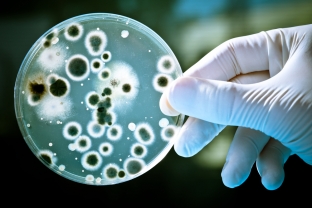"My home – my fortress". At home, a person feels safe. What a pity that we cannot hide from harmful microorganisms even in our own homes. Today we will tell you where the most infection is hiding in the house.
Kitchen
Hiding Place: Kitchen Sink and Faucet
There are about 80,000 bacteria per square centimeter of a kitchen sink. This is stated by WHO experts. Most microorganisms they found:
- on the surface near and inside the drain;
- on the faucet;
- as well as on sponges used for washing dishes.
And this is not strange, because in a humid environment, the infection multiplies very quickly. And leftover food from washing dishes also feeds bacteria.
How to fight
In order to avoid such accumulation of harmful microorganisms, you should:
- Rinse sink and faucet thoroughly after every dishwashing.
- Rinse cloths and sponges after each wash and dry them.
- Before putting dishes in the sink, throw away leftover food in the trash.
- Wipe the surface of the sink dry.
Where it hides: cutting boards and knives
The US Food and Drug Administration has named foods that are the main sources of bacteria. So most of them were found in:
- potatoes;
- berries;
- leafy vegetables;
- various greenery;
- raw meat.
Accordingly, after cutting the listed products, microbes remain on the cutting board and knife. From them, they can easily get on other products, on your hands and, accordingly, inside your body.
How to fight
To prevent this from happening, you need to:
- Rinse food thoroughly under cold running water before cutting and slicing.
- Knives and cutting boards should be washed with detergent and a brush.
- Store them separately from other kitchen utensils. That is, do not put cutting knives together with forks and spoons, and boards – with plates and pots.
- Purchase boards and knives separately for different products. Do not cut meat and vegetables on the same board.
- Choose plastic or glass boards as they do not absorb moisture and are harder for germs to grow on.
Bathroom
Where it hides: toothbrush
There are about a billion bacteria in the human mouth. Scientists have identified approximately 700 types of bacteria that are found in the oral cavity. About a hundred of them can cause serious diseases. The toothbrush does not kill them, but only collects them. Accordingly, microorganisms continue to multiply already on the brush and return to their usual habitat during the next brushing.
How to fight
Measures to take to avoid turning the brush into a breeding ground for harmful microorganisms:
- Rinse the brush with hot water. It is best to scald her with boiling water after each cleaning.
- Put the brush in a glass to dry.
- Do not put a wet brush in the case.
- Don't just put your brush on the bathroom shelf. This is fraught with the fact that even more bacteria accumulate on it.
Where it hides: the Soul Mesh
Back in 2009, scientists from the Simons College Hygiene Center in Boston (USA) examined the rooms of about three thousand volunteers. In about 25% of homes, scientists have found Staphylococcus aureus bacteria. Most of them were found on the shower head. Pathogenic bacteria have also been found near the drain, at the junctions of the bathtub and washbasin with the wall, and between the tiles.
How to fight
The first thing you need to remember – is that the bathroom should be washed with disinfectants at least once a week.
Also, the bathroom requires constant ventilation. The easiest way is to install a hood in it, which will work when the light turns on. But if finances do not allow, then you can just keep the bathroom door open.

Where is hiding: the floor of the toilet
There are more germs on the toilet floor than on the toilet seat. The reason for this is simple. Every time you drain the water, splashes of water fall on the floor, and along with them, pathogenic bacteria get there.
How to fight
To prevent microorganisms from multiplying on the floor in the toilet, you need:
- Close the toilet lid before flushing.
- The toilet floor should be cleaned at least once a week and with disinfectants.
- Toilet mats should be cleaned with hot soapy water. It must be changed at least once every six months.
Source estet-portal.com






Add a comment